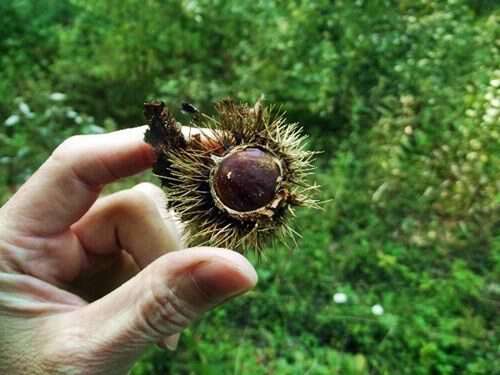
Chinquapin
The 1974 Winter Edition of the Foxfire Magazine contains a compilation of newspaper articles written by Harvey Miller. At the time of the magazine’s publication Miller’s weekly column had been around for sixty years and was till being published in the Tri-County News located in Spruce Pine, North Carolina.
1951
A large stack of fresh timothy hay, owned by Frank Bennett, was burned to the ground, when struck by lightning in one of the terrible electric storms here recently. Bennett owns a large mountain farm near Pigeon Roost on top of towering Rich Mountain, where the stack of hay was destroyed by the lightning. But several other stacks nearby escaped the fire. There is no wire fence close by any of the hay stacks. One elderly man here said this was the first hay stack that he had learned of being burned up by lightning in about sixty years.
9/20/51
1954
The cattle use the same wallows that were used by the elks and bears in the olden days to rid themselves of flies, which are surprisingly numerous on the high mountain tops. Cattle men claim the mud in the wallows is so sticky that one coating is enough to keep the flies from biting for several days or as long as particles of mud cling to the hair and hide. A large trough hewn from a chestnut tree many years ago and used as a salt lick is still being used. The trough, located directly opposite the Elk Wallow mud puddle, is in a good state of preservation except for a few small rotted places. It is still a convenient spot for cattle owners to place salt for the animals.
9/9/54
1960
John Parris, who writes Roaming the Mountains column in the Asheville Citizen, mentioned Pigeon Roost again on September 19. Parris told how some places in Mitchell, Avery and Yancey counties came by their names. Here are the words he said about Pigeon Roost Creek.: “Pigeon Roost goes back to the days when carrier pigeons darkened the skies by the millions.” Yes, that was right but he failed to say that Pigeon Roost was the roosting place for the pigeons.
Since the cool weather started, the farmers went to taking care of their crops very fast. They didn’t have to say it but they was afraid that a killing frost was going to come the way the weather looked. All farmers that we have talked to that have harvested their crops and put it in the barns said they were well pleased with the prospects. Chinquapins are beginning to get good and ripe.
9/29/60
—-
I hope you enjoyed the peek into Pigeon Roost via Mr. Miller.
Jump over to the Foxfire website and poke around. They are still publishing the magazine and those wonderful Foxfire Books too.
Tipper
Subscribe for FREE and get a daily dose of Appalachia in your inbox


Interesting mention of the Chestnut log where farmers placed salt for their cattle, we have a community in Swain County named Licklog, Licklog Creek which flows through the community enters the Little Tennessee River at Needmore. One of my ancestors had a log where he salted his cattle that was called a Licklog. “Papaw Ammons was raised across the mountain from Licklog.
Our ancestors weren’t dumb. They put the salt on a big log so it would leach down into the wood. That way when the livestock got a craving for salt they would just have to lick the log. The salt served to preserve the log therefore a licklog might outlast the pioneer farmer who first put it there. How many licks does it take to get to the center of a four foot diameter chestnut log?
I wonder if the hay stack had a center pole sticking up like a lightening rod?
There was a Pigeon Roost Creek where I grew up. The name demonstrates how historic conditions get memorialized in place names.
Sure do wish somebody would grow chinquapins commercially. But I suspect the yield per land area would be very low compared to other crops so I guess nobody wants to dedicate land to them.
Tipper, you and your two girls would be called the girls with the chinquapin eyes, for your beautiful brown eyes! I’m sure you’ve heard that.
I’ve never really thought about Pigeon Roost actually having carrier pigeons roosting there, not that the name’s not a dead give away, it’s just that I never thought about it.
My Dad loved John Parris, he looked forward to the daily articles in the newspaper as well as reading his books.
Life sure was simpler then!